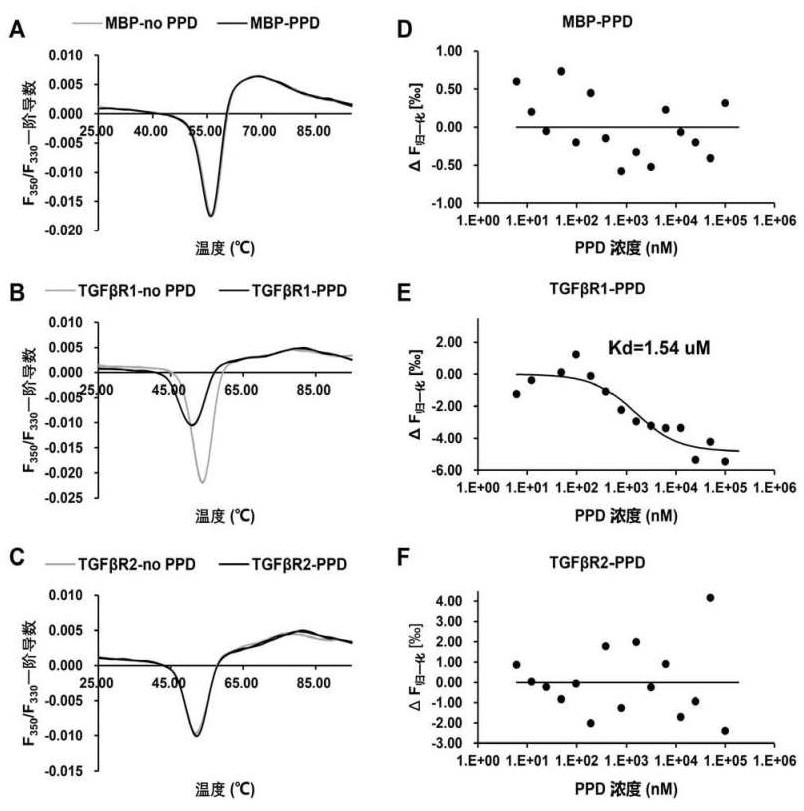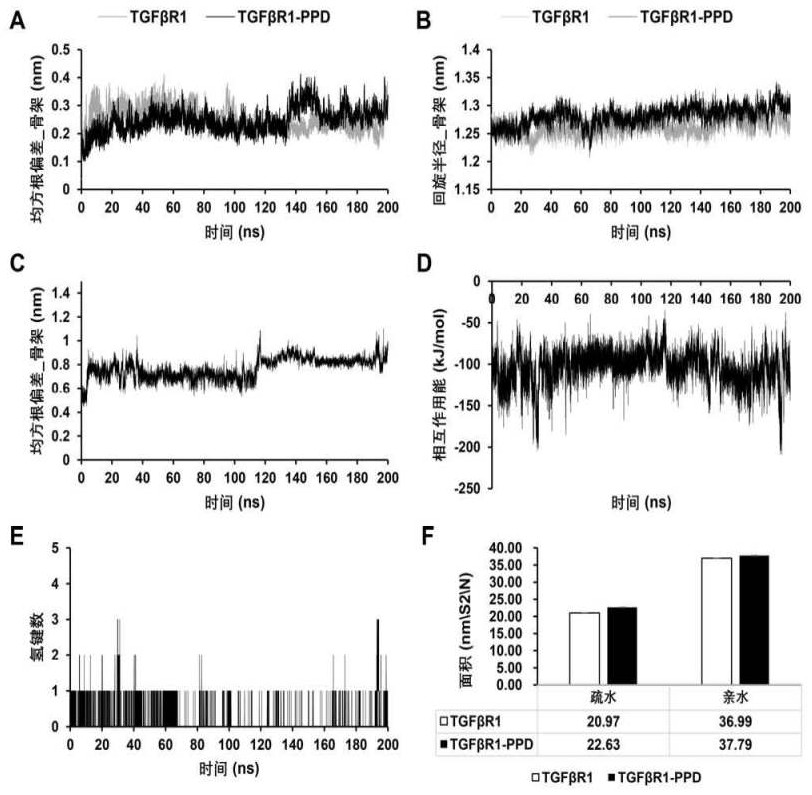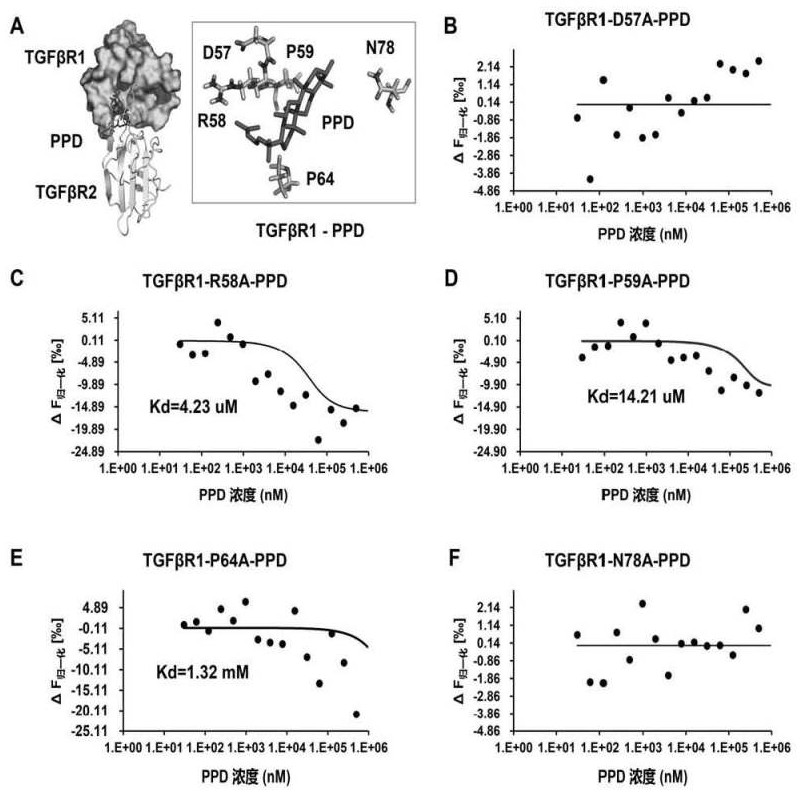Application of PPD in preparation of drugs for preventing or treating TGF beta pathway related diseases
A technology for use and disease, applied in the field of medicine and chemistry, to achieve the effect of treating diseases related to TGFβ pathway
- Summary
- Abstract
- Description
- Claims
- Application Information
AI Technical Summary
Problems solved by technology
Method used
Image
Examples
Embodiment 1
[0043] Example 1 Effect of PPD on protein stability of MBP, TGFβR1, and TGFβR2
[0044] In this application, in order to determine the stability of PPD binding to TGFβR1, TGFβR2 and MBP, the following experiments were carried out:
[0045] Mix 1mg / ml protein (TGFβR1, TGFβR2, MBP) with 400μM PPD (Jilin Mengchuang Biotechnology Co., Ltd., GR0515, the same below), and place it overnight at 4°C. Set up a protein control group without PPD, 2 for each group. Repeat, use the Prometheus NT.48 instrument (Germany nanotemper company) to measure the protein melting temperature Tm value, the principle of this instrument is to measure the change of the ratio of protein absorption at 350nm and absorption at 330nm at different temperatures, because tryptophan has fluorescence absorption at 350nm , tryptophan is a hydrophobic amino acid. When the protein structure is stable, tryptophan is located inside the protein, and the ratio of 350nm fluorescence absorption to 330nm fluorescence absorpti...
Embodiment 2
[0046] Example 2 Binding affinity of PPD to TGFβR1, TGFβR2 and MBP
[0047] In order to further measure the affinity of PPD with MBP, TGFβR1 and TGFβR2, we use the MST-nanotemper instrument (Germany nanotemper company), the steps are as follows:
[0048] 100 μL of 10 μM / L proteins (TGFβR1, TGFβR2, MBP) were labeled with fluorescent dyes respectively, PPD was diluted twice from 400 μM / L gradient, mixed with different concentrations of PPD and fluorescent dye-labeled proteins, and tested on the machine. The principle of the instrument is The sample is heated by an infrared laser to generate a microscopic temperature gradient field, and then the directional movement of the molecule is detected and quantified by a covalently bound fluorescent dye, so as to obtain the binding behavior of the PPD-protein. The results are as follows figure 1 , The dissociation constant Kd of PPD and TGFβR1 is 1.54μM, and PPD does not combine with MBP and TGFβR2.
Embodiment 3
[0049] Example 3 Kinetic simulation of PPD and TGFβR1 complex
[0050]In this application, in order to obtain the specific binding mode of PPD and TGFβR1, use AUTODOCK vina small molecule-protein (version 1.1.2, http: / / vina.scripps.edu / ) docking software, and GROMACS (version 2020.5, http: / / vina.scripps.edu / ) complex simulation software, first use AUTODOCK vina to dock PPD and TGFβR1 ectodomain structure to obtain the structure of TGFβR1-PPD complex, then use GROMACS 2020.5 software, use Charmm36-mar2019 force field, TGFβR1 -PPD is placed in a twelve-square box, TIP3P water molecules are added, the system neutralizes the charge with Na+ and Cl-, the NaCl concentration of the aqueous solution of the system is set to 0.15M (that is, the concentration of normal saline), and the energy is minimized first, so that the maximum energy of the system is less than 1000kJ / mol / nm, followed by a two-step equilibrium of the system to stabilize the temperature of the system at 300K and the ...
PUM
 Login to View More
Login to View More Abstract
Description
Claims
Application Information
 Login to View More
Login to View More - R&D
- Intellectual Property
- Life Sciences
- Materials
- Tech Scout
- Unparalleled Data Quality
- Higher Quality Content
- 60% Fewer Hallucinations
Browse by: Latest US Patents, China's latest patents, Technical Efficacy Thesaurus, Application Domain, Technology Topic, Popular Technical Reports.
© 2025 PatSnap. All rights reserved.Legal|Privacy policy|Modern Slavery Act Transparency Statement|Sitemap|About US| Contact US: help@patsnap.com



